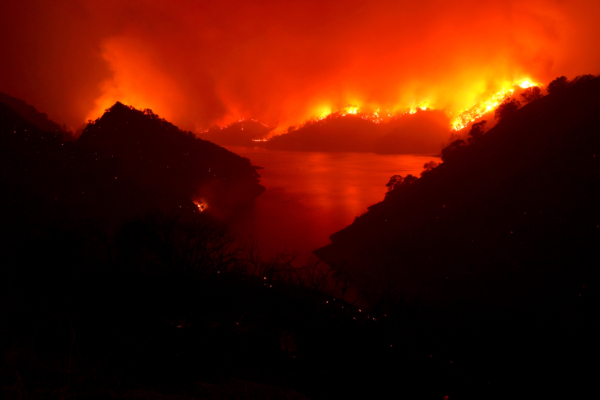California cannot escape the raging wildfires every year. In terms of area, the total land burnt by the top 10 largest wildfires in California history is equivalent to at least 15 times the size of Los Angeles. Many of these fires are caused by human activity.
According to the latest statistics from the California Department of Forestry and Fire Protection (Cal Fire), the top 10 largest wildfires in California history have collectively scorched nearly 4.9 million acres of land (approximately 7,654 square miles) since 1932. The entire area of Los Angeles city is only about 320,000 acres. These 10 wildfires have also destroyed thousands of buildings, resulting in dozens of deaths.
Based on the timing, 7 of these wildfires occurred in the past 5 years, with 5 happening in 2020. That year, California experienced a century-long drought, making it one of the most severe drought years in recent Western American history.
As for the causes of the fires, more than half are attributed to human activities such as arson and electrical problems, while some are ignited by lightning strikes.
The largest wildfire in California history was the “August Complex” that erupted in 2020. In mid-August of that year, lightning strikes sparked several smaller fires that merged into a massive disaster.
Within four months, the “August Complex” burned over 1.03 million acres of land across seven counties in northern California, accounting for about 1% of the entire state’s land. The fire also swept through the entire Coastal Range, destroying 935 structures and claiming one life.
The “Dixie Fire” that broke out in July 2021 in northern California burned through 963,000 acres of land and destroyed 1,311 structures over a span of more than three months, resulting in one fatality.
The California Fire Department reported that the fire was caused by power lines. Unlike complex wildfires, the “Dixie Fire” was the largest single wildfire recorded in California history.
To combat the blaze, authorities deployed thousands of firefighters, hundreds of fire trucks, helicopters, bulldozers, and water trucks. However, due to the drought and high temperatures, firefighting efforts proved to be extremely challenging.
Starting in July 2018, Mendocino, Lake, Colusa, and Glenn counties in northern California witnessed the devastation of the “Mendocino Complex Fire.”
According to data from Cal Fire, the fire was sparked when a rancher attempted to drive a metal stake into the ground to block a yellow jacket nest, creating sparks that ignited flammable materials. Ultimately, the “Mendocino Complex Fire” destroyed around 459,000 acres of land, 280 structures, and caused one fatality.
In July of this year, the “Park Fire” that erupted in northern California reshuffled the ranking of California’s largest wildfires. As of September 3, the “Park Fire,” which was 98% contained, had burned about 430,000 acres of land and 709 structures, becoming the fourth-largest fire in California history. Fortunately, there have been no reports of casualties.
This fire is believed to have been deliberately set by arsonist Ronnie Dean Stout, who was charged on July 29 for allegedly pushing a burning vehicle into a ditch known as “Alligator Hole,” triggering the massive fire that quickly spread.
The “SCU Lightning Complex Fire” that erupted in the San Francisco Bay Area and Central Valley in August 2020 burned approximately 397,000 acres of land. Cal Fire reported that the fire was caused by lightning strikes.
The area destroyed by this fire is equivalent to the size of 13 San Franciscos, and it razed 225 structures, with no reported fatalities.
The “Creek Fire” that broke out in Fresno County in September 2020 burned approximately 380,000 acres in the Sierra National Forest in central California. The Forest Service deployed helicopters to work through the night, rescuing about 385 people and 27 animals within a few days.
Tens of thousands of residents in Fresno and Madera Counties were forced to evacuate due to the wildfires, which destroyed over 850 structures. Despite no casualties, the cause of the fire remains a mystery, according to Cal Fire.
The “LNU Lightning Complex Fire,” which erupted in August 2020 in the North Bay Area, affected most of the wine country in northern California, burning approximately 363,000 acres of land.
This wildfire, ignited by lightning and arson, destroyed 1,491 local structures and resulted in six fatalities.
Also in August 2020, the “North Complex Fire” emerged as the eighth-largest wildfire in California history, proving to be extremely deadly. Numerous residents received emergency evacuation orders.
Initially sparked by lightning, the “North Complex Fire” rapidly escalated by early September, devastating the towns of Berry Creek and Feather Falls. The complex wildfire ultimately destroyed 319,000 acres of land, 2,352 structures, and resulted in 15 fatalities, with hundreds injured.
In December 2017, the “Thomas Fire” rapidly spread through Ventura and Santa Barbara Counties in southern California, becoming the largest wildfire in California history at the time.
This fire, caused by power lines, destroyed 1,060 structures and claimed the lives of two individuals. Most alarmingly, over 100,000 residents were forced to evacuate.
Ultimately, the “Thomas Fire” consumed roughly 281,000 acres of land, surpassing the combined area of New York City, Washington D.C., and San Francisco, making it the ninth-largest wildfire in California history.
The “Cedar Fire” that occurred in San Diego in 2003 was the sixth deadliest and fourth most destructive wildfire in California history.
Burning approximately 273,000 acres in San Diego County, the “Cedar Fire” destroyed 2,820 structures and caused 15 fatalities, including one firefighter. Cal Fire reported that the fire was human-caused.

